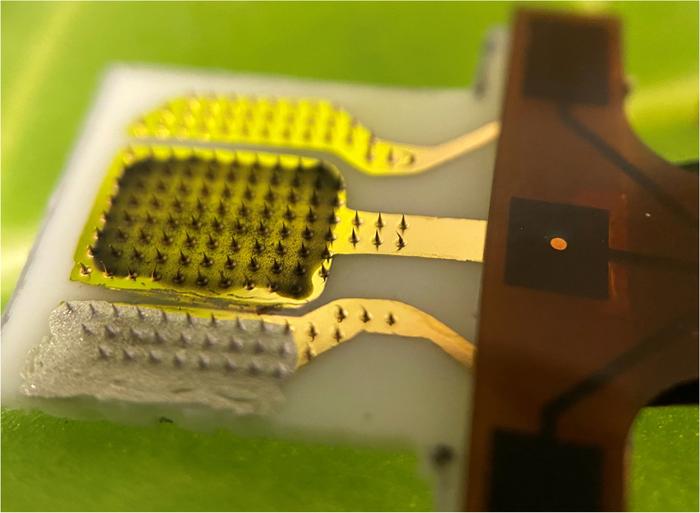In an era where agriculture grapples with the mounting pressures of climate change, pest infestations, and infectious diseases, the early detection of plant stress has emerged as an invaluable tool for farmers and home gardeners alike. Researchers at Iowa State University have recently unveiled an innovative wearable patch that could revolutionize plant monitoring by providing real-time insights into the health of crops. This remarkable development, published in the journal ACS Sensors, offers hope for sustainable agriculture practices and heightened crop yields, even under challenging environmental conditions.
The primary function of this groundbreaking device is its ability to detect hydrogen peroxide—a well-known marker of stress in plants like soybeans and tobacco. Under normal circumstances, plants maintain a delicate balance in their biochemical processes. However, environmental stressors such as drought, extreme temperatures, and pest attacks can disrupt this balance, prompting plants to produce hydrogen peroxide as a physiological response. By accurately detecting changes in hydrogen peroxide levels, the wearable patch can effectively signal distress in real-time, allowing growers to intervene before visible signs of damage, such as wilting leaves or discoloration, occur.
One of the standout features of this sensor is its practicality. Traditionally, detecting hydrogen peroxide in plants has involved invasive methods, requiring the removal of plant parts and processing steps that delay the response to stress signals. In contrast, this novel device hinges on a non-invasive approach, allowing the sensor to be applied directly to the underside of plant leaves. This seamless attachment ensures continuous monitoring, significantly enhancing a grower’s ability to respond swiftly to potential issues.
To construct this innovative patch, researchers employed an array of microscopic plastic needles that were incorporated into a flexible base. This unique design was crucial for ensuring that the patch could adhere securely to the leaves while remaining efficient and functional. Once the structural components were combined, the researchers coated the microneedles with a hydrogel-based mixture containing a specialized enzyme. This enzyme is highly responsive to hydrogen peroxide, enabling the conversion of chemical changes into measurable electrical signals.
The versatility of the detection mechanism is one of the patch’s many advantages. During testing, the patches were employed on both healthy soybean and tobacco plants, as well as on plants that were subjected to stress through bacterial infection. Remarkably, the electrochemical sensor reliably indicated higher levels of electrical current in stressed plants compared to their healthy counterparts. This increase in current directly correlated with the concentration of hydrogen peroxide present, validating the sensor’s efficacy.
Notably, the response time of the wearable patch is exceptionally fast. Researchers reported that the patches can detect hydrogen peroxide levels and relay crucial information back to growers in under a minute. This rapid assessment could dramatically alter the approach to crop management, enabling growers to make informed decisions in real-time. Given that timely interventions are critical in agricultural settings, this innovative device could serve as an essential tool for safeguarding crop health and optimizing yields.
Moreover, the patches showcased remarkable reusability, retaining their structural integrity even after multiple applications. Researchers found that each patch could be utilized up to nine times before the microscopic needles began to lose their form. This durability reduces waste and provides a cost-effective solution for farmers, with the researchers estimating that each test would cost less than a dollar—an accessible price point for growers aiming to monitor and manage their crops more effectively.
The research team, led by Liang Dong, is enthusiastic about the implications of their findings. They are focused on further refining the technology to enhance its usability and reusability. As the field of wearable sensors in agriculture continues to evolve, the potential applications for real-time plant health monitoring could extend beyond crop production to areas such as environmental conservation and sustainability practices.
The intersection of technology, agriculture, and environmental science has never been more vital. With a growing world population and the pressing need for sustainable agricultural practices, innovations such as this wearable sensor could pave the way for a future where real-time monitoring and analysis become the norm rather than the exception. As scientists and researchers look to the future, it is clear that harnessing the power of technology to enhance agricultural practices will be crucial for meeting the challenges of tomorrow.
The development of this wearable patch aligns with wider trends toward precision agriculture, where data-driven technologies empower farmers to make informed decisions about crop management. By transitioning from reactive to proactive approaches in plant care, growers can optimize their resources, reduce wastage, and ultimately contribute to global food security in an increasingly uncertain climate.
As the research continues to progress, ongoing studies will undoubtedly shed light on the broader implications of such monitoring technologies. The holistic integration of sensors in agriculture not only enhances productivity but also complements the goals of sustainable practices and ecological preservation. The outcome of this research has implications that extend far beyond the laboratory, potentially influencing agricultural policies and practices on a global scale.
In conclusion, the development of a wearable patch for plants that can detect stress signals through hydrogen peroxide monitoring signifies a momentous leap forward in agricultural technology. This innovation exemplifies how scientific research can intersect with practical applications to effect meaningful change in farming practices. The future of agriculture lies in the precise understanding of plant health, and this wearable sensor could be a linchpin in achieving that vision.
Subject of Research: Wearable Sensor Technology for Real-Time Monitoring of Plant Health
Article Title: A Biohydrogel-Enabled Microneedle Sensor for In Situ Monitoring of Reactive Oxygen Species in Plants
News Publication Date: 19-Mar-2025
Web References: ACS Sensors Journal
References: ACS Sensors DOI: 10.1021/acssensors.4c02645
Image Credits: Adapted from ACS Sensors 2025, DOI: 10.1021/acssensors.4c02645
Keywords
Plant Monitoring, Hydrogen Peroxide Detection, Agricultural Technology, Crop Health, Sustainable Agriculture, Precision Agriculture
Tags: climate change impact on agriculturecrop health assessment toolsearly warning systems for plant healthenvironmental stress response in plantshydrogen peroxide detection in cropsimproving crop yields through technologyIowa State University researchnon-invasive plant monitoring solutionspest and disease management in cropsreal-time plant stress monitoringsustainable farming innovationswearable agricultural technology





